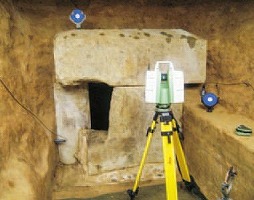
NABUNKEN NEWS vol.49
Survey of the Kitora tomb (Asuka-Fujiwara No. 173‒8)
In June, 2010, the Nara National Research Institute for Cultural Properties surveyed the inside of the stone chamber of the Kitora tomb to probe and record the structure of the chamber, conditions of the rocks, and the remaining state of the red lines (made of cinnabar) drawn on the stone, and traces of the bier (Asuka-Fujiwara No. 170). At that time, however, we were unable to sufficiently examine a certain part of the south-side wall, due to a tomb robber's hole on the south wall, and because the equipment to facilitate entry into the chamber is installed in the robber's hole, covering over that part.
Accordingly, for this survey, we removed the equipment, and investigated on/around the part of the tomb robber's hole. The investigation period was from February 18 to 27, 2013. The investigation was jointly undertaken by three institutes; the Nabunken, the Archaeological Institute of Kashihara, Nara pref., and the Asuka Village Board of Education.
In this investigation, we probed the shape of stones, traces of processing remaining on the stone surface, stone-combination patterns, etc. and used various methods of recording, including actual measurements, rubbing (ink impressions), photography, and 3D laser surveying. The record of inside the stone chamber has thus been completed in conjunction with the 2010 investigation results.
Furthermore, as the internal conditions of the stone chamber during this investigation were better than those of the 2010 investigation, we could newly identify more than 50 spots of the red lines remaining drawn on the stones. Added to the number of red lines confirmed through past investigations, the total red lines confirmed to date reached 24, provided that the remains of some lines forming a single straight line are counted as one. These red lines were conceivably used as baselines for processing the stones.
This investigation is the final to survey the stone chamber inside of the Kitora tomb; and from now on, our work is to move to the closure of the stone chamber and improvement of this kofun (burial mound). We would like to use the new discoveries and data we acquired through this investigation for the future improvement and utilization of this burial mound.
(WAKASUGI Tomohiro, Department of Imperial Palace Sites Investigations)
 Surveying using the 3D laser scanner |
